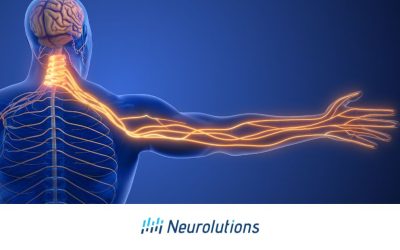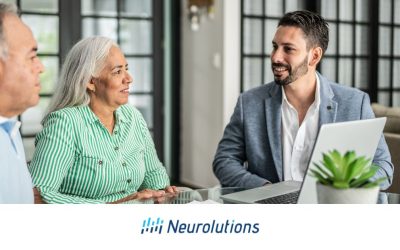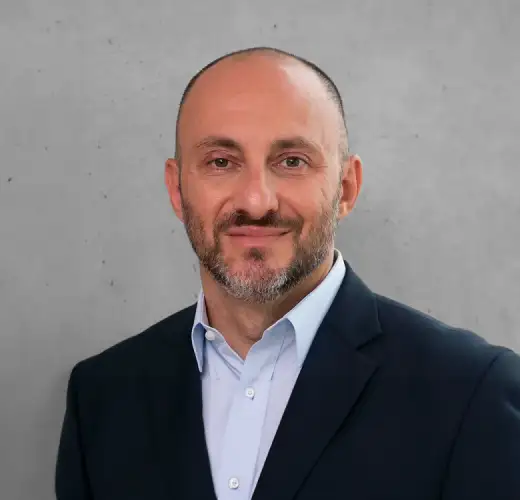What Is a Stroke and What Happens to You After a Stroke?
A stroke is a type of brain attack. It happens when the blood flow to the brain is blocked by a clot in a blood vessel.
The most common symptom of a stroke is sudden numbness or weakness on one side of the body, but there are many other symptoms. The symptoms can vary from person to person, and can also depend on which part of the brain was affected by the stroke.
A stroke can cause problems with speech and language, memory, thinking skills, movement and coordination, sensation, and awareness. Strokes are very serious but recovery from symptoms is possible.
Post-Stroke Challenge – Spasticity
What is spasticity?
Spasticity is when a muscle contracts involuntarily, which causes tightness. Depending on the severity and location of this spasm, it can cause pain.
As you move a spastic arm or leg faster, there will be an increase in muscle tone and resistance to being moved. Put simply, there will be more muscle tone and resistance to movement the faster you try to move.
Why does spasticity occur?
Because of the brain damage caused by a stroke, the muscles, brain, and nervous system cannot properly connect, which is what causes spasticity.
Where is spasticity most likely to happen?
Spasticity is most common in the upper extremities (wrist, elbow, and fingers). For example, a survivor may be unable to unbend their arm or unclench their fist without assistance.
Treatment of Spasticity
There are a few different options when it comes to the treatment of spasticity.
Physical and Occupational Therapy for Spasticity
Physical or occupational therapists may perform stretches, use myofascial release techniques, and teach stroke survivors range-of-motion exercises and at-home stretching techniques. Exercises that increase resistance may be added if necessary. Therapists recommend positioning guidance of the limb as well. However, these types of treatments improve mobility and prevent contractures rather than treating spasticity directly. Sometimes, devices that use electrical current to change muscle firing patterns are utilized to mitigate spasticity and offer the opportunity to incorporate the affected limb into functional tasks. Alongside doctors and other specialists, therapists are a vital part of a larger integrated team in the spasticity management plan of care.
Splinting and Bracing for Spasticity
Hand and wrist bracing and splints are commonly prescribed to prevent contracture, reduce excessive tone, lengthen shortened tissue, prevent skin breakdown, increase or maintain range of motion, and improve alignment. Studies conclude that splinting and orthoses likely do not improve spasticity, upper limb motor function, dexterity, daily activities, or muscle strength, but they may improve range of motion. If you or someone you know is prescribed one, be sure you receive proper education on its purpose, precautions, and wearing schedule. When there is movement in the hand and wrist, it is not recommended splints and bracing that do not allow for movement be worn for long periods as it discourages the use of the hand and therefore hinders brain recovery.
Oral Medication for Spasticity
Common medication prescribed for spasticity may include:
- Baclofen
- Benzodiazepines
- Dantrolene sodium,
- Imidazolines
Baclofen, a muscle relaxer, is the most commonly used. Muscles are relaxed by baclofen by acting on the central nervous system. It decreases stretch reflexes, the rate of muscle spasms and clonus, pain, and tightness, and improves range of motion.
Baclofen has yet to be proven effective in stroke survivors, and it appears to have limitations with spasticity. This is because the quantity of Baclofen required to reduce spasticity results in adverse side effects due to its limited ability to cross the blood-brain barrier
All common medications can have severe side effects, be sure to discuss all possibilities with your doctor in depth before deciding on treatment.
Botox for Spasticity
Botulinum toxin (Botox, Myobloc, & Dysport) can be injected into the spastic muscles to temporarily stop the connection between muscles and nerves, which stops spasms. Effects typically begin within 24 to 72 hours of the injection and peak after about 2 weeks. The effects can last for 3-4 months at a time. Many people will return for additional injections if they find the treatment is beneficial.
Surgical Treatments for Spasticity
As a last resort, surgery can release or lengthen muscles, and/or release tendons. Muscles can also be “denervated,” which means the supply of nerves is cut off.
A physician should discuss surgical options when other methods have not worked, and there is sufficient reasoning to go for this treatment, for example, severe deformity, difficulty with basic hygiene, or a good prognosis for functional improvement.
Post-Stroke Challenge – Flaccidity
What is flaccidity?
Flaccidity is characterized by a complete loss of muscle tone resulting in severe muscle weakness. The paralysis due to nerve damage prevents nerves from receiving signals from the brain. Sometimes, the entire limb (both arm and leg) will be flaccid with weakness in the trunk and stomach muscles on the same side. Other times, there might be only select groups of the arm or limb that are paralyzed. This is most common directly after a stroke occurs, and usually only affects one side of a stroke survivor’s body. If and when strength does return, a classic pattern of recovery is for the shoulder muscles to get stronger before the further away muscles of the wrist and hand recover after stroke. This does not happen for everybody who suffers a stroke.
Treatment of Flaccidity
Physical and Occupational Therapy
Therapists use a variety of techniques to start getting brain cells and their neural pathways back “online” again if the muscles have little to no reflexes and when there is little movement. The therapist will select exercises and special positions that will place challenge and demand on the muscle to work and therefore become stronger. Because there is often reduced sensation in the paralyzed region, activities designed to produce a relearning of touch, temperature, and stretch experiences are included. Electrical stimulation used over weak muscles to “wake up” the part of the brain that communicates to that region can be utilized repetitively or incorporated during functional tasks that the individual wants to accomplish.
There are no surgeries or drugs that work to treat spasticity. However, there are new, breakthrough stroke rehabilitation devices that utilize the brain’s power of thinking to restore movement. Nevertheless, a robust rehabilitation program with a therapist and consistently sticking with a home program is key.
Post-Stroke Challenge – Language Challenges and Aphasia
What is Aphasia?
Aphasia results from damage to the language-processing portions of the brain, making it difficult to speak, understand, read, and write languages, even if you are a native speaker. Aphasia may occur at the same time as other speech disorders that result from brain damage, such as dysarthria or apraxia of speech.
Types of Aphasia
Wernicke’s Aphasia
With Wernicke’s aphasia, a person may speak in complete and long sentences that do not make sense. The speaker will add words that are unnecessary, or even made-up, which makes it difficult to understand them. Additionally, they may have difficulty understanding the language that they are hearing or reading.
Broca’s Aphasia
Broca’s aphasia refers to a language difficulty in which a person may understand speech, and knows what they would like to say, but the person frequently omits small words (such as “the,” “or,” “and,” etc.) and struggles to form full sentences. Because sufferers of Broca’s aphasia typically have a good comprehension of clothes’ speech, it is common for them to be aware of their difficulties and get frustrated.
Treatment of Aphasia
If an aphasia diagnosis is suspected, the patient is typically referred to a speech-language therapist. The speech therapist will examine the person’s ability to understand language, converse, express ideas, read, and write are all assessed.
A person with aphasia can go through aphasia therapy to improve the way they communicate by mobilizing remaining language abilities, restoring as much of lost language ability as possible, and learning new ways to communicate. Group therapy provides a small-group setting where the survivor can learn new communication skills in addition to their individual therapy. For people who continue to have difficulty, speech-generating apps on smartphones and tablets can provide an additional or alternative means of communication.
There is research showing that language and communication abilities can improve continuously and some have shown new activity in tissue near the damaged area of the brain. Among the factors that could affect the improvement are the cause of the brain injury, the area and extent of the damage to the brain, and the individual’s age and overall health.
Post-Stroke Challenge – Vision Changes
What happens to a person’s vision after a stroke?
Not everyone will have visual disturbances after a stroke, but a stroke can cause problems with eyesight and/or how the brain sees the world (i.e. perception). When there is damage to the brain or optic nerve or pathways, several visual symptoms could result. Examples include losing half or portions of the visual field or double vision. Some people may have difficulty coordinating their eye muscles together to scan when reading, following a moving object, or trying to stay still to focus on an object. They may lose track of their targeted object, have trouble seeing the full scene around them, or experience blurriness. They can also feel dizzy.
In many cases, there is no damage to the structures of the eyes or how they function. Instead, the root cause is damage in the brain and failure to understand and interpret what is seen. This symptom is known as a visual perceptual problem. Some of these visual perceptual problems that interfere with a person’s function include difficulty interpreting spatial relationships of shapes and objects, judging distances, determining when a cup is almost full, challenges with finding objects in a drawer, or confusion making out letters when reading. A person may appear clumsy and even be considered unsafe as they attempt to interact with the world around them while reaching, handling objects, and walking.
Treatment of Vision Disorders
Many times vision disorders are overlooked or misinterpreted by healthcare professionals. Therefore, it is highly important a person identified as having a vision disorder after a stroke be evaluated by specialists who understand stroke symptoms and proceed through several assessments to determine the origin of the problem. Understanding the distinction between the many types of vision problems is highly important when it comes to providing proper treatment.
Occupational therapists who treat stroke, vision specialists, optometrists, and neuro-ophthalmologists often take part as a team to provide comprehensive care. Sometimes, special glasses or eye patching are needed, while other times, eye exercises to strengthen lazy eye muscles to focus better are crucial. The person may need to work on strategies to overcome or compensate for a field loss and increase awareness of their surroundings. Many times, a person participates in activities that challenge the brain’s understanding of spatial relationships, discriminating between objects or forms, or reaction time of their body to a moving object.
Both the survivor of the stroke and their support network must be educated on the vision problem and ways to encourage relearning, return to tasks, and keep them safe.
Additional Post Stroke Challenges
In addition to the symptoms listed above, stroke causes other impairments in the body that cause functional problems and interferes with an individual’s ability to complete activities as they did before. These additional post-stroke challenges include, but are not limited to:
- difficulty walking
- balance problems
- difficulties with executive functioning skills (e.g. planning, logical reasoning, time management, working memory)
- mood and personality changes (e.g. depression, anxiety, reduced interest in things, impulsivity)
- swallowing difficulties
- incontinence
- sleep disturbances
- sexual dysfunction
The degree to which these problems affect the individual vary person to person. Not all of these problems are always permanent.
Conclusion
There are many post-stroke challenges that individuals face after having a stroke. It is important to be aware that there is a problem when something does not seem right. Then, seek professional help to define the problem so appropriate treatment and management can be provided. There are many services, groups, and treatment organizations that want to help those dealing with post-stroke challenges improve their function and wellbeing.
Resources
If you or someone you know is dealing with any of these symptoms and challenges, here are a few resources that may help you better understand them and ways to seek help.
American Heart Association and American Stroke Association
Canadian Stroke Best Practices
Need more help and direction? Contact our clinical team at Neurolutions. We are skilled experts in stroke rehabilitation and are happy to help steer you in the right direction. Email: info@neurolutions.com
References
Stroke Recovery Clinician Handbook
Spasticity after Stroke- Stroke-Rehab.Com
National Institute on Deafness and Other Communication Disorders
Know Stroke- Post-Stroke Rehabilitation
Canadian Stroke Best Practices
Evidence-Based Review of Stroke Rehabilitation
Guidelines for Adult Stroke Recovery- APTA
Guidelines for Adult Stroke Recovery and Rehabilitation- AHA





